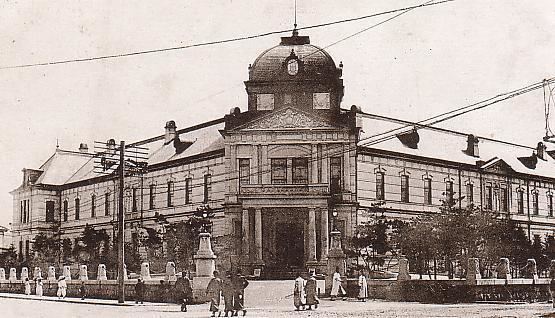Former type Private Ceased operations 1945 | Defunct 1945 Founded 1908 | |
 | ||
The Oriental Development Company (Shinjitai: 東洋拓殖株式会社, Hangul: 동양척식주식회사, Hanja: 東洋拓殖株式會社), established by the Empire of Japan in 1908, was a national enterprise built as a colonial exploitation policy towards the Korean Empire and other countries in East Asia. The company was headquartered first in Seoul, then in Tokyo.
Contents
Foundation
In 1905, the Empire of Japan made a treaty with the Korean Empire called the Japan–Korea Treaty of 1905. As a result, the Korean Empire became a protectorate of the Empire of Japan. This treaty deprived Korea of its national sovereignty.
The treaty also allowed the Empire of Japan to build the Japanese Government-General Building in Seoul and appoint a resident-general.
The treaty of 1905 led to the foundation of the Japan-Korea Treaty of 1907. In March 1908, the National Diet of Japan passed the bill establishing the Oriental Development Company that the government of Korea was forced to sign. It was initially managed by both the Korean Empire and the Empire of Japan. When the headquarters were moved to Tokyo in 1917, it became wholly owned by the Empire of Japan.
In 1927 Na Seok-ju, a Korean independence movement activist, bombed the building in Seoul, which resulted in the death of some of the managers. Despite this incident, the company started to create more branches in countries abroad, such as Taiwan, Manchuria, Sakhalin, and South Pacific Mandate. In 1938 there were nine branches with over 800 employees.
Migration
Due to a decrease in arable land in Japan, Imperial Japan decided to establish migration policies that would help people move to the Korean Peninsula to farm. It has been estimated that the Korean branch of the company accepted 85,000 Japanese people in 1904, and about 500,000 had migrated there by 1908.
Company land had been given to Japanese colonists up to the spring of 1924, amounting to more than 8,000 landmass and normal immigrants reached 246,767, thus put together, forming one-seventh of the whole arable land attained by Japanese migrants.
Along with other government support for migration, the practice of "subleasing" was adopted. Japanese people who moved to Joseon were allowed to initiate tenant farming subleasing to Joseon people who lived there originally.
Land investment
After Imperial Japan did the Cadastral Survey, by the late 1920s the company had bought one third of the arable lands in the Korean Peninsula. They forced tenants to pay over 50% of their production for rent, while the possessions of Japanese migrants rose 300% to 400% per year across the Korean Peninsula.
The large amounts of landmass held by Japanese migrants gained taxes for the authorities. Indigenous farmers lost their independence.
According to Arthur C. Bunce, land tenure was the most common approach for farmers, since there was not other employment. 75% of Korean farmers became tenants.
Life in Hwanghae province (in modern North Korea) was described by the .
Owing to bad harvest, caused by the flood, drought, and attacks by insects, poor and wretched tenants have pleaded over a month that they must have been exempt from paying the rents, or that the rents must have been reduced, for the year. . .regardless of how old they are, most of residents came to the local office of the Oriental company and pleaded the cancellation of the tax. The local agents of the company threatened, however, that the farmers shall lose their tenant rights in case they do not pay the rents.
Other investments
After the Mukden Incident in 1931, Imperial Japan started to transform the Korean Peninsula into a supply base. Soon, the company invested in electricity and railroad to exploit mines.
Aftermath
After Korea was liberated by the Allies, the United States Army Military Government in Korea confiscated all company property. Soon, this became Shinhan Gongsa, operating in six major cities of South Korea. It later owned and controlled the landmass of Oriental Development Company.
After the First Republic of Korea was established, the lands that belonged to Oriental Development Company were distributed to farmers by the 1949 Land Reform.
Oriental Development Company buildings still exist in Busan and Mokpo. Two buildings have been converted into museums to document incidents when Korea was under Japanese rule. The building in Seoul is now occupied by the Korea Exchange Bank.
